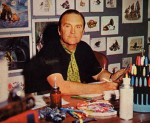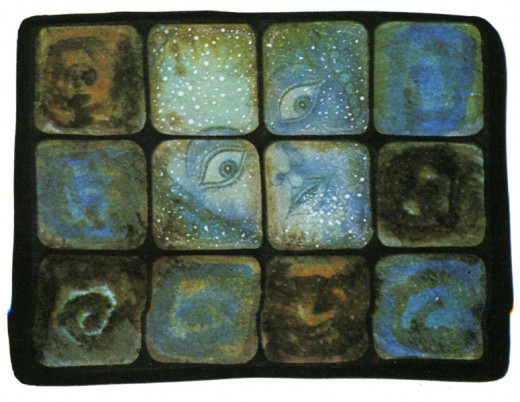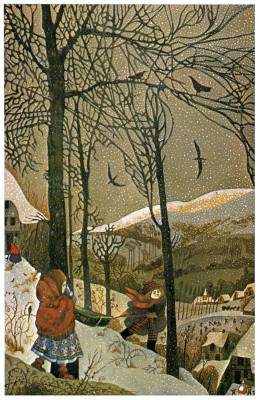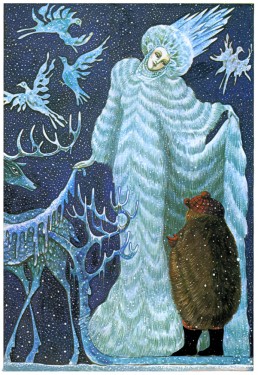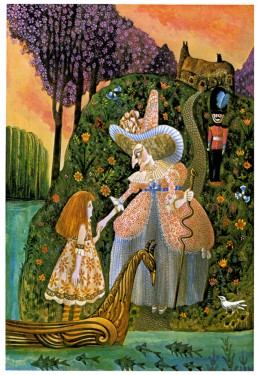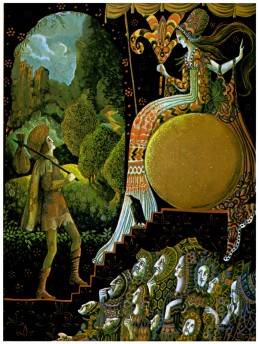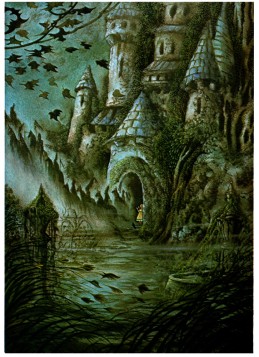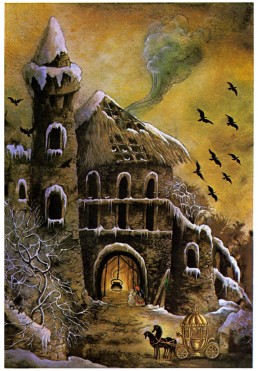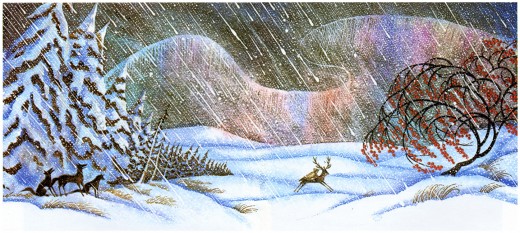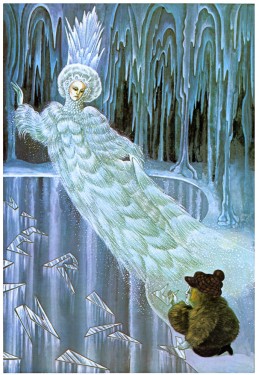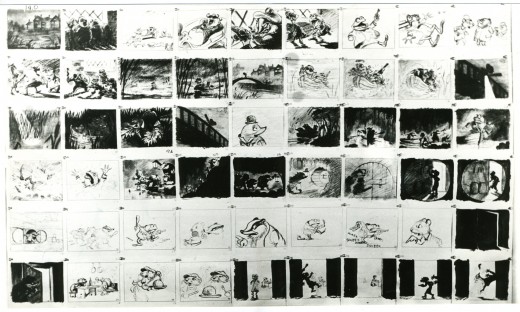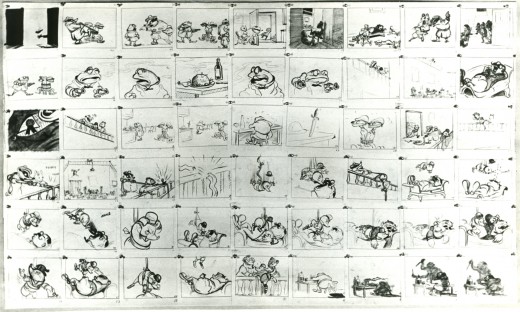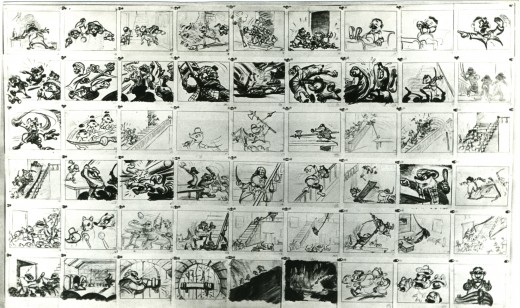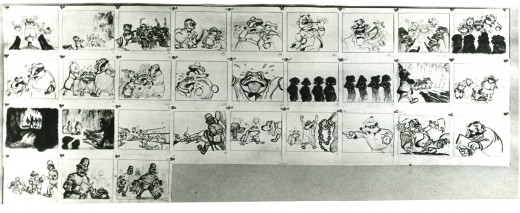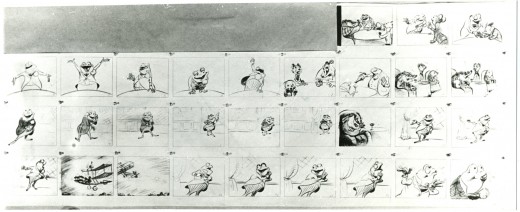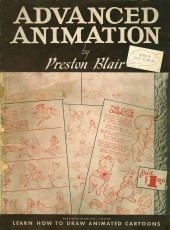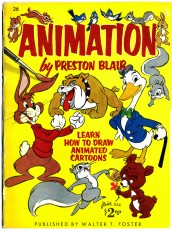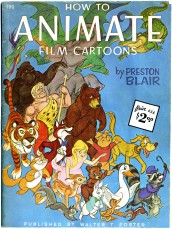Monthly ArchiveApril 2007
Animation &Commentary 30 Apr 2007 08:02 am
Blum Commentary
- I read an editorial in an April 10th issue of The NYSun, and thought I’d put all of the attention of today’s blog into it. Normally, I wouldn’t put up an entire piece like this, but what the hell? I like it, and I don’t want it go completely unnoticed.
The commentary is by David Blum and is called
. . . . . . . . . . . . . . . . . . . . . “Who’s Laughing Now?”
- Is it genuinely funny to see an animated, overweight, middle-aged dude on a living room couch, waiting for the chorus of the “Maude” theme song to kick in? To me it’s mildly amusing, but I don’t think I’m supposed to be the target audience for Fox’s “The Family Guy,” where that reference turned up on a recent episode. Very few 12-year-olds have a working knowledge of theme songs from 1970s sitcoms, and those who do need to get into something more useful, like stamp collecting. But this is what happens when you entrust the writing of prime-time cartoons to adults. They write what they know. And if you’ve ever met a Hollywood television comedy writer, you know that most of them grew up with baby sitters named Sony and Panavision.
 It’s not fair that so many jokes on television’s most popular cartoons don’t work for people who don’t shave. That’s the target audience, and who Hollywood hopes to attract by turning these cartoons into movies themselves — “The Simpsons” movie opens in July, and the Cartoon Network’s “Aqua Teen Hunger Force” full-length version arrives in theaters this Friday. Maybe a few smart kids will get these shows’ highbrow allusions to movies like “The Natural” and “2001: A Space Odyssey,” but most preteens don’t get these nods to the past, and their parents don’t do much more than note them and nod off.
It’s not fair that so many jokes on television’s most popular cartoons don’t work for people who don’t shave. That’s the target audience, and who Hollywood hopes to attract by turning these cartoons into movies themselves — “The Simpsons” movie opens in July, and the Cartoon Network’s “Aqua Teen Hunger Force” full-length version arrives in theaters this Friday. Maybe a few smart kids will get these shows’ highbrow allusions to movies like “The Natural” and “2001: A Space Odyssey,” but most preteens don’t get these nods to the past, and their parents don’t do much more than note them and nod off.
Okay, so I was home as a kid watching memorable movies and sitcoms, too, and I get the gags on “Family Guy” — most of them, anyway. But they’re more likely to make me wince at my vast, unnecessary knowledge of trivia than laugh at the repetition. A single episode contains so much material culled from television that it’s impossible to keep track of it all; one random episode included mentions of “dingo and the baby” (an homage to the 1988 Meryl Streep movie, “A Cry in the Dark), “Masturbator & Commander” (after the Russell Crowe movie “Master & Commander”), and an ice-cream-and-punishment sequence lifted directly from the 1980 Academy Award-winning movie, “Kramer vs. Kramer.”
There’s so much material in “Family Guy” taken from elsewhere that it inspired ridicule on an episode of “South Park,” in which the show’s writers were portrayed as manatees getting their joke notions from “idea balls” spinning freely in a giant bin.
 The writers at “The Simpsons” aim higher than “Family Guy,” but sometimes end up in the same place — with lines that resonate more with memory than humor. “As God is my witness,” Homer Simpson declares in one episode as he begins a new diet, “I’ll always be hungry again!” Is that funny, or is it just familiar? I don’t think there’s all that much entertainment value in a television version of Trivial Pursuit, and that’s what television cartoons have largely become — a catalog of lines from old movies, theme songs from 1960s sitcoms, and mentions of actors like David Hasselhoff. I’m probably the only person in my ZIP code to catch the “Simpsons” reference to Fox’s 1991 sitcom trainwreck “Herman’s Head,” and that’s not a proud moment.
The writers at “The Simpsons” aim higher than “Family Guy,” but sometimes end up in the same place — with lines that resonate more with memory than humor. “As God is my witness,” Homer Simpson declares in one episode as he begins a new diet, “I’ll always be hungry again!” Is that funny, or is it just familiar? I don’t think there’s all that much entertainment value in a television version of Trivial Pursuit, and that’s what television cartoons have largely become — a catalog of lines from old movies, theme songs from 1960s sitcoms, and mentions of actors like David Hasselhoff. I’m probably the only person in my ZIP code to catch the “Simpsons” reference to Fox’s 1991 sitcom trainwreck “Herman’s Head,” and that’s not a proud moment.
The cannibalizing of the actual classics will result in another, more pernicious effect in the years to come — taking away the pleasure for kids of seeing the original source material from which great lines and memorable scenes are taken. When the latest generation of preteen cartoon-watchers grows up and sees the horse’s head sequence from “The Godfather,” they’ll have the implanted memory of the “Simpsons” episode in which Bart found the head of the Jebediah Springfield statue in his bed. Won’t that reduce the shock value, later in life, of seeing John Marley wake up to the sight of his silk bedsheets drenched in blood? The entire “Treehouse of Horror V” episode functions as a parody of “The Shining,” a movie most “Simpsons” fans won’t see for years. All references and no jokes make “The Simpsons” a dull show.
 This isn’t meant as a broadside against “The Simpsons,” which even at its weakest spins its thievery with wit and remains one of television’s finest achievements. And “Family Guy,” for all its dependence on cultural references and quotations, manages to be funny much of the time. It’s just that when the references become as tired as they’ve grown lately — “Family Guy” has, most recently, been borrowing from the comedy stylings of Carol Burnett, who has reciprocated by suing — you start to wonder about the point. Even more troubling than the trend itself may be the prospects for the future of cartoons. What will be left for the animated-comedy writers of tomorrow to borrow? At least this generation had some good material to use. Given the current scarcity of classic movies, it’s not implausible to imagine cartoons of the future stealing from Stewie Griffin of “Family Guy” or channeling Homer Simpson for their scripts. Will our children’s children find that funny? I seriously doubt it.
This isn’t meant as a broadside against “The Simpsons,” which even at its weakest spins its thievery with wit and remains one of television’s finest achievements. And “Family Guy,” for all its dependence on cultural references and quotations, manages to be funny much of the time. It’s just that when the references become as tired as they’ve grown lately — “Family Guy” has, most recently, been borrowing from the comedy stylings of Carol Burnett, who has reciprocated by suing — you start to wonder about the point. Even more troubling than the trend itself may be the prospects for the future of cartoons. What will be left for the animated-comedy writers of tomorrow to borrow? At least this generation had some good material to use. Given the current scarcity of classic movies, it’s not implausible to imagine cartoons of the future stealing from Stewie Griffin of “Family Guy” or channeling Homer Simpson for their scripts. Will our children’s children find that funny? I seriously doubt it.
– Don’t miss Mark Kennedy‘s blog, Temple of the Seven Golden Camels. Today, it features Ken Anderson‘s African sketchbooks.
Anderson was a Disney artist/designer most of his life. He was one of the old-time animation guys who used real life for his inspiration, not other cartoons or television shows. He was something of a Renaissance man for Disney.
Photos 29 Apr 2007 08:21 am
Cranes are Flying
 New York seems, at the moment, to be undergoing enormous construction. (Or is it reconstruction?) One can’t help but come upon cranes of every size occupying whole blocks and streets making traffic somewhat complicated – both auto and pedestrian.
New York seems, at the moment, to be undergoing enormous construction. (Or is it reconstruction?) One can’t help but come upon cranes of every size occupying whole blocks and streets making traffic somewhat complicated – both auto and pedestrian.
The crane to the left can be seen from many blocks away. It occupies 30th Street and Madison Ave. This is an enormous piece of equipment. From a block away it virtually looks as tall as the Empire State Building, behind it. (Of course, it’s significantly shorter, but can you imagine what they needed to construct that building!)
Interestingly enough, there’s a second crane – albeit much shorter – half a block away which is working on another construction site. At times, traffic backs up for blocks. See both in the image below.


Here are two other views of the same two cranes. The tall one from a block away looking down over a couple of buildings. The image on the right is the short crane as seen from the base of the tall crane.
 If you look up to 42nd St from 14th St, you see a mass of construction going on uptown. Even just out of the frame on both the left and right, there’s more. The crane below is to the left at 18th Street. It’s enormous when standing straight up and down. Here it’s bent to pick up materials.
If you look up to 42nd St from 14th St, you see a mass of construction going on uptown. Even just out of the frame on both the left and right, there’s more. The crane below is to the left at 18th Street. It’s enormous when standing straight up and down. Here it’s bent to pick up materials.
I like the color of the sky against all the cranes pushing into the sky at the right.


Here’s another shot of the same crane from the other side of a building.
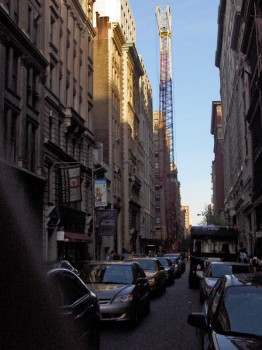

The crane above is on 19th Street just east of Broadway. Traffic seems to have learned how to maneuver around these things as it flows without too much difficulty.
I like the physical appearance of these machines. They’re almost attractive in their ugliness. Some of them, like this one, has a cab at the base which harbors a driver who moves the crane about. Others, the larger ones, seem to be built into a construction site of their own. There’s definitely a form to them, and they also seem to match the mesh that covers many of the buildings.


(Two views of the Empire State Building from 23rd Street.)
However, all you have to do is look at some of the buildings left behind,
and everything’s OK.
Puppet Animation &Theater 28 Apr 2007 10:00 am
Out Damn Spot
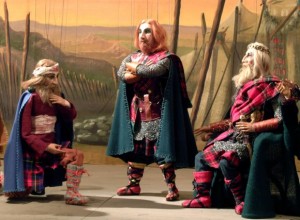 – Last night I saw a program at the New Victory theater on the revamped 42nd Street. (This theater was built in 1900 by Oscar Hammer-stein I and is the oldest theater on the block. It predates the Ziegfeld Follies!)
– Last night I saw a program at the New Victory theater on the revamped 42nd Street. (This theater was built in 1900 by Oscar Hammer-stein I and is the oldest theater on the block. It predates the Ziegfeld Follies!)
The program was Macbeth, as performed by marionettes. The Compagnia Marionettistica Carlo Colla e Figli is the world’s oldest puppet troupe. It was established in the late 18th century in Milan and has been in operation ever since.
Anyone who his visited my studio or home has a good idea that I might be a marionette fan. They’re tucked into many a corner of my spaces. When I was a child I made them out of muslin and made clothes for them as well (and consequently learned how to sew). I bought them at expensive toy stores (I treasured the Lady and the Tramp puppets that I had.)
I built a puppet theater and charged admission to the kids of the neighborhood to come see 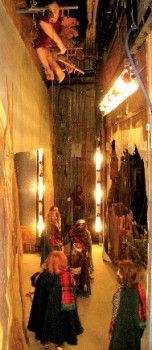 the shows. (The candy counter made all the money.) With the cash, I bought more puppets and put on more shows.
the shows. (The candy counter made all the money.) With the cash, I bought more puppets and put on more shows.
I was intrigued with the very popular Bil and Cora Baird (maybe sometime I’ll tell you about my interview with Bil Baird for a job in his company), and the show I saw in their Barrow Street theater – Jack & the Beanstalk – was the last marionette program I saw prior to last night’s Macbeth.
Marionettes have specific problems – mechanical ones.
Strings have to be hidden, unless you’re some kind of avant garde puppeteer who wants to call attention to them. The longer the strings, the greater the problems.
Gravity is another problem. Puppets often seem to be weightless, and to some degree, they are. They’re held aloft by the overhead puppeteer manipulating them. Hence, walks often look comical. It’s easier for them to glide along rather than imitate a walk.
Puppet animation has a great advantage since they’re moved ahead and manipulated frame by frame. They can be made to do anything a human can, if the animator is good enough.
The program last night had an enormous set filling a stage. There was always a foreground area – a beautiful wooded setting, painted to look like a Romantic watercolor of the 18th century or a castle made of bricks – which left an opening of about 10 ft wide by 8 ft high. (This is purely speculation from the 8th row.) Above the opening, of course, are the puppeteers. About ten of them work above the stage; they took a bow at the end to reveal themselves.
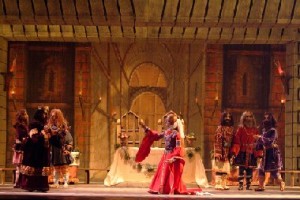 There were six actors who sat in the orchestra pit with their backs to us. Their performances, I thought, were a bit uneven. Macbeth, himself, was brilliant until it came time for him to say some of the character’s great lines. They were also miked, and the sound didn’t come from the stage but from speakers. The puppeteers, however, were so expert that I didn’t have any confusion in knowing which puppet was speaking.
There were six actors who sat in the orchestra pit with their backs to us. Their performances, I thought, were a bit uneven. Macbeth, himself, was brilliant until it came time for him to say some of the character’s great lines. They were also miked, and the sound didn’t come from the stage but from speakers. The puppeteers, however, were so expert that I didn’t have any confusion in knowing which puppet was speaking.
Within the framing device were many beautiful sets in which the puppets would work. All of the settings were elaborate and theatrical, all of them complex. Large scenes employed upwards of twenty marionettes moving about. In one opening scene, four men talked in the foreground while endless groups of characters walked behind them – several on horseback.
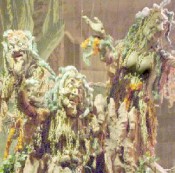 Yes, there were infrequent laughs at how the characters walked (especially the horses), but the manipulation had to have been the best I’ve seen, and for the most part you bought it. Team America captured quite a bit of the funny part of marionettes, but Macbeth captured some of the greatness of them.
Yes, there were infrequent laughs at how the characters walked (especially the horses), but the manipulation had to have been the best I’ve seen, and for the most part you bought it. Team America captured quite a bit of the funny part of marionettes, but Macbeth captured some of the greatness of them.
I would have liked the show to have been a bit more theatrical – the lights, the sets, the puppet performances were all magnificent, but the writing could have incorporated less of the talk and more of the violence of the story. The company seemed to be trying to show the subtleties they could perform with the marionettes, and they succeeded. I wish they balanced the climaxes in the show a little more carefully when they set about abbreviating Shakespeare’s tragedy.
Sorry, I have a hundred more things to say about the subject, so I allowed myself to ramble here. I will come back to it, and be a little more organized in my writing. But the show was sterling and shouldn’t be missed. It plays through this weekend at the New Victory Theater.
Books &Errol Le Cain 27 Apr 2007 08:10 am
Le Cain – The Snow Queen
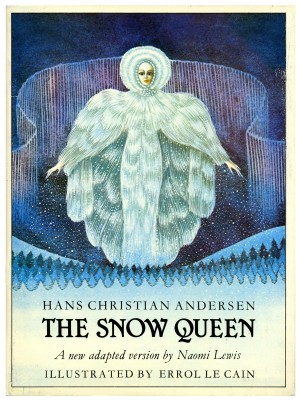 – I continue here to post some of the illustrations from another book by Errol LeCain.
– I continue here to post some of the illustrations from another book by Errol LeCain.
Errol was a longtime artist at Dick Williams’ Soho studio. He was the force behind the design and backgrounds of Dick’s endless feature film, The Cobbler and the Thief. When I first saw a BBC documentary about Dick’s work in the early 70′s, I was hooked on his films and his ambitions and his love of animation. The shorts I saw by Dick, including Love Me Love Me Love Me, only increased that excitement. In the BBC doc, there Dick talked about Errol LeCain as someone he’d taken under his wing and had him do the brunt of the work on the short film, The Sailor and the Devil. The short clip from this film made me a LeCain fan, and I started collecting his books.
In 1959, Columbia pictures released an animated feature of The Snow Queen. This was a reworked Russian animated film – interestingly enough, Dave Fleischer gets the credit for the reworking. The film was voiced by Tommy Kirk and Sandra Dee, and it came to me at a very impressionable age. Sleeping Beauty had taken hold of me, and 101 Dalmatians was on its way. I fell in love with this beautiful Russian film – even in the reworked version.
When LeCain’s book was released, I scarfed it up. I wasn’t disappointed by the stunning illustrations. About half of them follow:
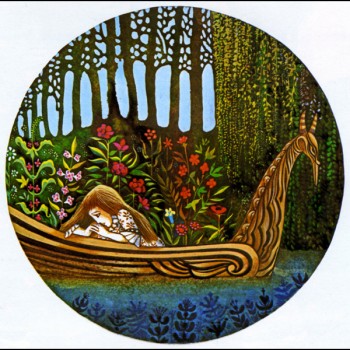
Animation Artifacts &Story & Storyboards 26 Apr 2007 08:02 am
Last of the Wind in the Willows board
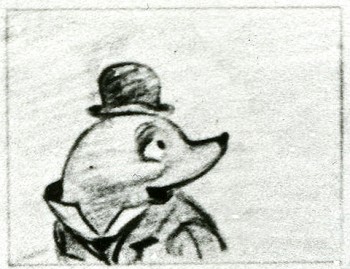
- Here are the remaining images I have of the storyboard from The Wind In The Willows. They come courtesy of John Canemaker and his extraordinary collection, and I have to thank him for sharing.
Though the images come from an early version of the feature that was truncated for the final Adventures of Mr. Toad, you can see that even at the start, Mr. Toad was the focus of the animated adaptation. It’s understandable considering how much of the action sits in Toad’s story. However, the charm and beauty of the brilliantly written book comes from other points, and it’s obvious that the Disney studio was always going to miss that.
There are some beautifully drawn images here, though, and I like how they lay out the action. Check out the drawings on the last board; beautiful poses throughout that sequence. There’s something that didn’t work quite as well in the final version done for the compilation film. That film has an overenergetic breathlessness that is so unlike the book.
Books 25 Apr 2007 07:45 am
HOW-TO
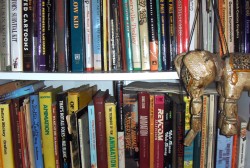 - We’re down to the nitty gritty with my book notes. There are so many books out there that it’s difficult to narrow down the books I like. I’ve talked about history of animation books; I’ve written about books out of print.
- We’re down to the nitty gritty with my book notes. There are so many books out there that it’s difficult to narrow down the books I like. I’ve talked about history of animation books; I’ve written about books out of print.
Today, I’d like to talk about HOW-TO books I like which are still available, and which I’d thoroughly recommend. By this, I mean books which tell how the nuts and bolts of animation are put together and that can get you inspired to do some hard work. None of these books are brand, spanking new; they’ve all weathered a bit of time and have proven themselves. They’re all still readily available, and I’ve given links.
- Dick Williams is an entity unto himself.
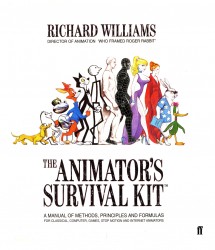 He was a dynamo in animation production for all those years he chose to make films. We all know about the legend of The Cobbler and the Thief and how the film was besmirched by the money lenders and takers. But the point behind Dick, it seems to me, is the people he inspired and the industry he rejuvenated single-handedly. For a while, thanks to the economic examples of Hanna-Barbera and Lou Scheimer, there was little good animation to be seen. The medium was in a desperate state with animators trying to imitate the horrible animation of the silent films of J.R.Bray when Dick Williams entered the scene and taught the world to love the work of the masters. He trained many animators to do great work, and he inspired hundreds of others.
He was a dynamo in animation production for all those years he chose to make films. We all know about the legend of The Cobbler and the Thief and how the film was besmirched by the money lenders and takers. But the point behind Dick, it seems to me, is the people he inspired and the industry he rejuvenated single-handedly. For a while, thanks to the economic examples of Hanna-Barbera and Lou Scheimer, there was little good animation to be seen. The medium was in a desperate state with animators trying to imitate the horrible animation of the silent films of J.R.Bray when Dick Williams entered the scene and taught the world to love the work of the masters. He trained many animators to do great work, and he inspired hundreds of others. 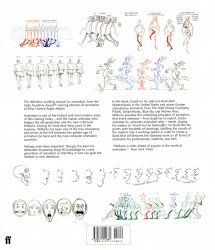
His legacy may be the book he developed which not only teaches, but it encourages and inspires.
Years ago, in the 70′s, the underground book that was passed around animaton was Dick’s lecture notes from the Art Babbitt lectures he’d hosted at his own studio in London. An ever-growing book of hundreds of xeroxed pages done in Dick’s own writing, the book took Dick’s own notes and made them useful to inbetweener trainees. (Somehow they seem more about how to inbetween than to animate.)
It’s obvious that Dick took these notes, cleaned them up and revised them to create his own book. And it’s excellent.
(The front and the back cover of the Williams book.
The back cover gives a good sample of what’s in it.)
In some ways, Dick’s book most reminds me of the Preston Blair book (see below).
It starts with basic principles of animation and movement and ultimately breaks into specific rules that have been developed over the years. The Blair book spends a lot of time trying to 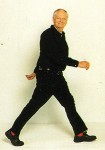 teach readers how to draw the traditional animation cartoon character. It does this prior to giving some real hard principles of animation layed out in a clear and simple way. The Williams book doesn’t spend as much time on the How-To-Draw part, but it does go into motion and has to be a gem for any neophyte animators out there.
teach readers how to draw the traditional animation cartoon character. It does this prior to giving some real hard principles of animation layed out in a clear and simple way. The Williams book doesn’t spend as much time on the How-To-Draw part, but it does go into motion and has to be a gem for any neophyte animators out there.
Get this book if you really want to know about animation, how things move and why. It’s a gem, and it doesn’t matter if you’re a 2D animator or a cgi animator. The principles are the same, and this book teaches you to respect those principles.
(Dick Williams always seems
to be walking in his photos.
.
The Williams studio in London created a British animation empire as well as a tradition that has thankfully slipped onto the rest of the world. A number of graduates of the Soho studio have developed their own world.
Tony White won the BAFTA award for his first solo Independent short, Hokusai. He eventually went into business for awhile and did some great commercial work.
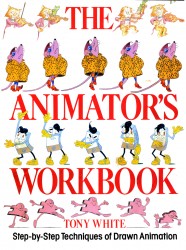 He also wrote and designed a brilliant book on animation, The Animator’s Workbook: Step-By-Step Techniques of Drawn Animation.
He also wrote and designed a brilliant book on animation, The Animator’s Workbook: Step-By-Step Techniques of Drawn Animation.
The book clearly and specifically gives lessons on animation and process. It’s attractively arranged and illustrated; the lessons are clear and certain; the information is supported by the experience of a gifted animator. I heartily recommend the book for the advanced animator as well as for the serious novice.
Tony has a second book which came out last year, Animation from Pencils to Pixels: Classical Techniques for the Digital Animator. I have to admit I haven’t purchased the book. An associate within my studio has a copy and says it’s much more complex in its layout and format. It comes with a dvd which illustrates the lessons in movement.
I have such respect for Tony and his work, that I’ll eventually buy the new book and will read it carefully. I can’t imagine his doing any better than he did with the first effor, but this gifted animator/director undoubtedly has a lot more to say, and I look forward to it.
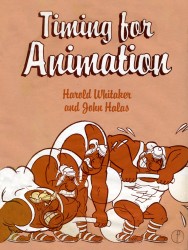 Another British animator whose book I’ve recommended several times in the past is Harold Whitaker. He was a gifted animator who worked at the Halas and Batchelor studio for many years, and he seems to have been the backbone of that studio in some of its later years.
Another British animator whose book I’ve recommended several times in the past is Harold Whitaker. He was a gifted animator who worked at the Halas and Batchelor studio for many years, and he seems to have been the backbone of that studio in some of its later years.
His book Timing For Animation has to be one of the finest books on 2D animation that I can recommend. I’ve said this on this site at least twice in the past – here and here – but I certainly have no compunction about plugging the book again.
I’ve posted the hardcover jacket but have linked to the paperback version. It’s a great book, and you should get it regardless of the version. I used to copy off pages as lesson-plans for the classes I taught at NYU. Go for it.
Finally, today, let me show you the book that started it all (not counting the 1920 Lutz book). Animator, Preston Blair, made himself famous among up-and-coming animators when he created an over- sized but slim, paperback book for the Walter T. Foster company. The book, Animation by Preston Blair, was designed to be sold in art stores and was featured at a very low price.
The book, over the years, has come in many different covers. For a while, they sold it at a higher price combining it with a slightly more advanced version done by Blair and retitling it to Cartoon Animation (The Collector’s Series).
It’s still the best bang for the buck.
Actually, you don’t even have to buy it. Go to ASIFA Hollywood Animation Archive and download a copy for yourself (print it out if you like.) I also suggest you follow the course they suggest in conjunction with John Kricfalusi. There’re a lot of interesting bloggers out there showing off their versions of Blair’s drawings/walk cycles and animation. You can’t help but learn from it. Start here and advance your way through it. The brilliance of the internet in action.
Animation &Daily post 24 Apr 2007 07:44 am
NFB ET AL
Before I point you in the direction of the NFB, take a look at Mark Mayerson‘s continuation of his “Mosaic” of Pinocchio. Does it get any better than this? It’s like looking at a grand version of the director’s workbook. You get to see the cutting so front and center. It’s just beautiful. Thanks and great work, Mark! You’re a treasure.
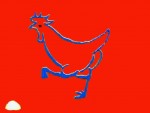
- The National Film Board of Canada has a program/project that’s designed to encourage new talent. It’s called Hothouse, and this is the program’s fourth year. Eight emerging filmmakers are spending twelve weeks at the NFB Animation studios in Montreal to create a 30-second film on the theme “A Chance Encounter.”
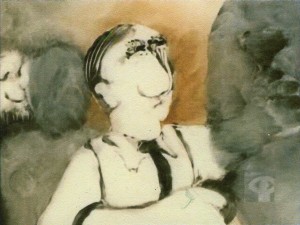 Torill Kove, whose NFB/Norway co-produced The Danish Poet received this year’s Oscar for Best Animated Short, is this year’s mentoring director. You can view the films in progress from this year’s Hothouse, and you can also view past years’ productions.
Torill Kove, whose NFB/Norway co-produced The Danish Poet received this year’s Oscar for Best Animated Short, is this year’s mentoring director. You can view the films in progress from this year’s Hothouse, and you can also view past years’ productions.
In case you didn’t know, you can also view quite a few of the Film Board’s greatest films on-line, for free. There are 50 films available here.
If you haven’t seen The Street or Two Sisters by Caroline Leaf, what are you waiting for?
There’s an interesting article in today’s NYTimes about Ratatouille and Pixar’s work with Disney. It’s all about the marketing. (Especially with a title that’s confusing to pronounce for the “Freedom Fries” half of America.) I expect we’ll see quite a few more articles like this in coming weeks.
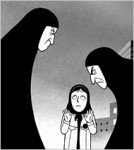 Speaking of French, congratulations to Persepolis now in competition at the Cannes Film Festival. It’s not often an animated film gets into competition there, and this one is 2D. Marjane Satrapi should be flying about now, and my kudos to her and her codirector, Vincent Paronnaud.
Speaking of French, congratulations to Persepolis now in competition at the Cannes Film Festival. It’s not often an animated film gets into competition there, and this one is 2D. Marjane Satrapi should be flying about now, and my kudos to her and her codirector, Vincent Paronnaud.
Finally, my congratulations to Tom Sito for his film Adventures in the National Palace Museum getting into the Cannes Film Festival.
That’s a coup!
Animation Artifacts &UPA 23 Apr 2007 08:22 am
Oh, Taurus!
Today, I’m posting a cel Tissa David gave as a gift to Heidi for her birthday in February. It’s time for Taurus, and it’s an appropriate day to post this beautiful cel setup from UPA.
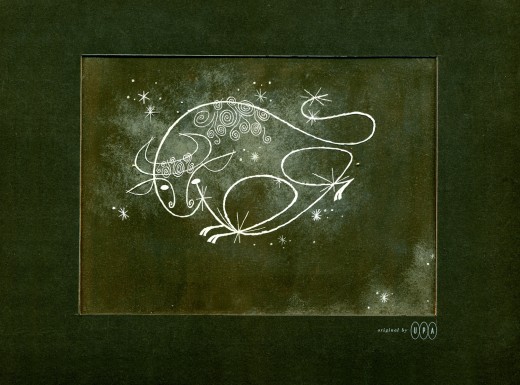
Tissa said she was given the cel shortly after arriving at UPA New York in 1956. Obviously, the image comes from a film done prior to 1956.

Obviously, I don’t have a clue as to what film it’s from. I thought that it, perhaps, came from one of the shorts done for the McBoing Boing show, but I haven’t been able to locate it. I also thought that perhaps it was done for a commercial.
If anyone out there knows, please check in with me. The first person who comes up with the correct answer will receive a gift from me.
I’m honored to have made Tom Sito‘s memorial blog roll today. What a guy, what a memory!
Photos 22 Apr 2007 08:12 am
More of an Art Project
This week I returned to Madison Square Park to see how the new steel trees have taken root. Were they cleaned up and manicured?
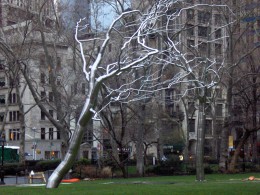 1
1 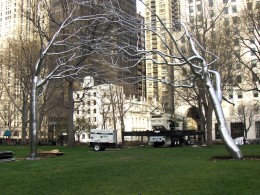 2
2
No, it still looked something like a construction sight. However, there was something new in the air. The vehicles had moved to another point in the park.
 3
3 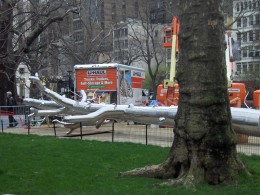 4
4
A new tree had landed. There it was, a fatter one on its side with its branches askew just as the first pair of trees had originally appeared. Obviously this is to be a bigger art project than I had expected, and I’d have to return to see the progression.
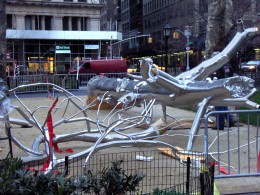 5
5 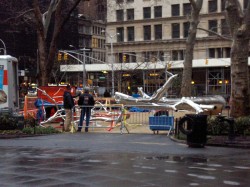 6
6
But there was more . . .. . . . . . . . .
. . . . . . . . .
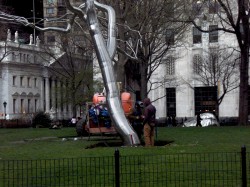 7
7 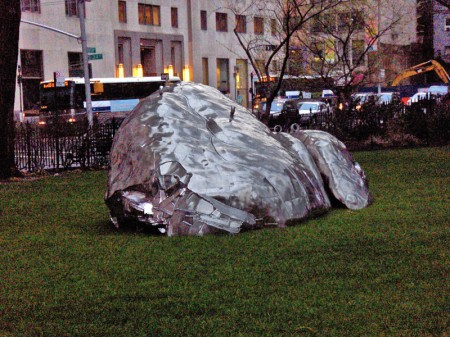 8
8
A shiny squat object elsewhere in the park.. . . . . . . . . . . . . . . . A rock!
. . 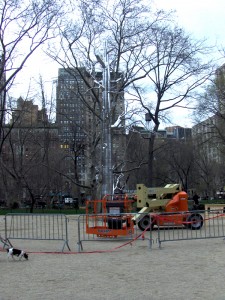 9. . .
9. . .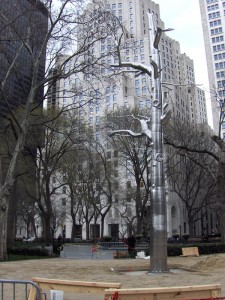 10
10
A day later, the single, squat tree has been righted. I have to say it’s not as impressive as the ones that took a week to construct. We’ll have to see how they all look once the manicuring job of the grounds has been done.
While these steel trees are in construction, real trees are doing their own thing. The
flooding rains of last week left us with magnolia trees blooming around town.
 . .
. . 
A small corner plaza outside an apartment building on 22nd Street has a group of trees
that are glowing.
 . .
. . 
The Episcopal Church, on Fifth Avenue, has a show on display just outside its front doors.
 . .
. . 
Washington Square Park has a tree or two that are in bloom as well.
Daily post 21 Apr 2007 08:35 am
16mm & B-B-B-B-Blogs
 – Last night we tried something different around here. I pulled out the old,
– Last night we tried something different around here. I pulled out the old,
lo-tech 16mm projector and I dusted off some of my collection for a small gathering of friends. Pizza and cartoons always works.
It helps to put together an eccentric program sometimes. I let the music do the walking and put together a musical tour. (Some might say torture.)
The program was a loopy one:
- . I have a scope section of Pencil Test from Raggedy Ann & Andy – Tissa David’s “Candy Hearts and Paper Flowers” section. We watched this first because it was the only scope film I was showing. There’s a whole big lens change for Cinemascope. So I was able to set it up before anyone came, and just pull off the lens after that film.
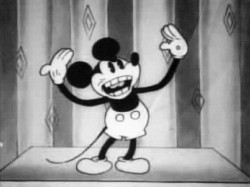 . From there we went back to the 1929 Mickey Mouse Club sing-a-long of “Minnie Yoo Hoo” which I have attached to a rare trailer for Snow White. I don’t think animation was done yet, because the entire trailer is in live action.
. From there we went back to the 1929 Mickey Mouse Club sing-a-long of “Minnie Yoo Hoo” which I have attached to a rare trailer for Snow White. I don’t think animation was done yet, because the entire trailer is in live action.
. Jumping to New York’s Fleischers I programmed “The Little Dutch Mill” since this has my favorite Fleischer 3D multiplane use. The cinecolor has faded from red and aqua blue to one color – magenta. Somehow, that didn’t hurt the film.
. Back to MGM, we saw “To Spring” with the multitudes of gnomes bringing on the spring (appropriately, it was a beautiful day – finally – in NY) and “Swing Wedding” which includes Louis Armstrong and Fats Waller as frogs performing in the swamp.
. Clair de Lune with the Debussy track. This was done for the proposed Fantasia 2 and included in a later feature compilation as Blue Bajou.
. George Dunning’s “The Tempest.” was for the art crowd in me.
. Leave ‘em with a laugh. You can’t go wrong with Tex Avery’s “King Sized Canary,” and I didn’t go wrong.
Basically, I let music guide the program moving from the Minnie’s Yoo Hoo chant to swing and classical through modern and gave it all up for a laugh. It made for a lot of fun. If you have a 16mm projector, I suggest you try it. So much more fun than dvd/video.
- There are a couple of blogs/sites I rush to visit every day, and I thought I’d take a couple of minutes to tell you about them. There are those that I am religious about visiting, even if and though I suspect nothing’s changed. The four I’ve pointed to often enough include:
My favorite animation reading is still at Michael Barrier‘s site.
And I also look forward to reading what Mark Mayerson has to say about some of the classic works of animation art. His is an invaluable site.
Of course there’s also Cartoon Brew, Cartoon Modern (get there today to see Walt Peregoy designs), and Hans Perk’s A Film LA are immediate stops.

- However, after those four I jump to two favorites I haven’t given attention to.
Uncle Eddie’s Theory Corner is right up at the pinnacle among the favorites. Time to lighten up. This guy is the funniest man out there (he should have his own TV series, animated or otherwise.) His drawings always on display – they change daily – is Don Martin on some kind of high. However, Eddie’s knowledge is enormous; it’s not just for laughs. There’s depth here.
Check out some of his posts about art here or cartoonists here or women here or comedy here or lots of other subjects.
It all seems scattered, except for two things. They all tie back to animation and how to do it well. And they all come out of the mind of Eddie Fitzgerald who has to be one of the most positive and original voices I look forward to reading every day. Even when he says he won’t be there for four days I go back to see if just maybe . . .
I love this site. (By the way, check out the Fry & Laurie films he’s posted today. Stephen Fry has always been a favorite of mine, and Eddie features him today.)

- Blather from Brooklyn is another one of my favorite visits, and it’s usually how I end my blog reading in the morning.
The site has nothing to do with animation, (unless you feel as I do that everything has to do with animation) but it gives an incredible view of the New York I love. Because of the title, I originally thought the site was Brooklyn-centric, but I was wrong. There are posts about artwork around town here, haiku created from gravestones here, or photos of the Easter Parade on Fifth Avenue here. The site is by Annulla (not much more is revealed, but (s)he also has another blog called Annulla Cooks, and it’s great if you’re into recipes and cooking.
I used to visit Rachelle Bowden‘s blog for her travel around NY, but she now is in Chicago. Fortunately, I also like Chicago – though it’s no New York. And she’s also into food.
